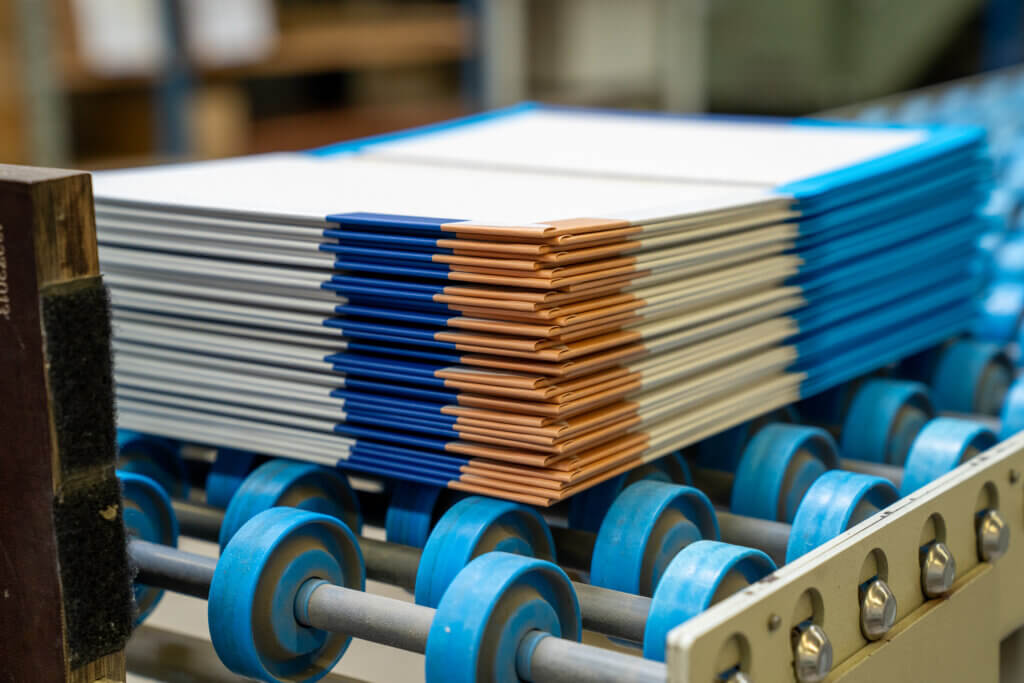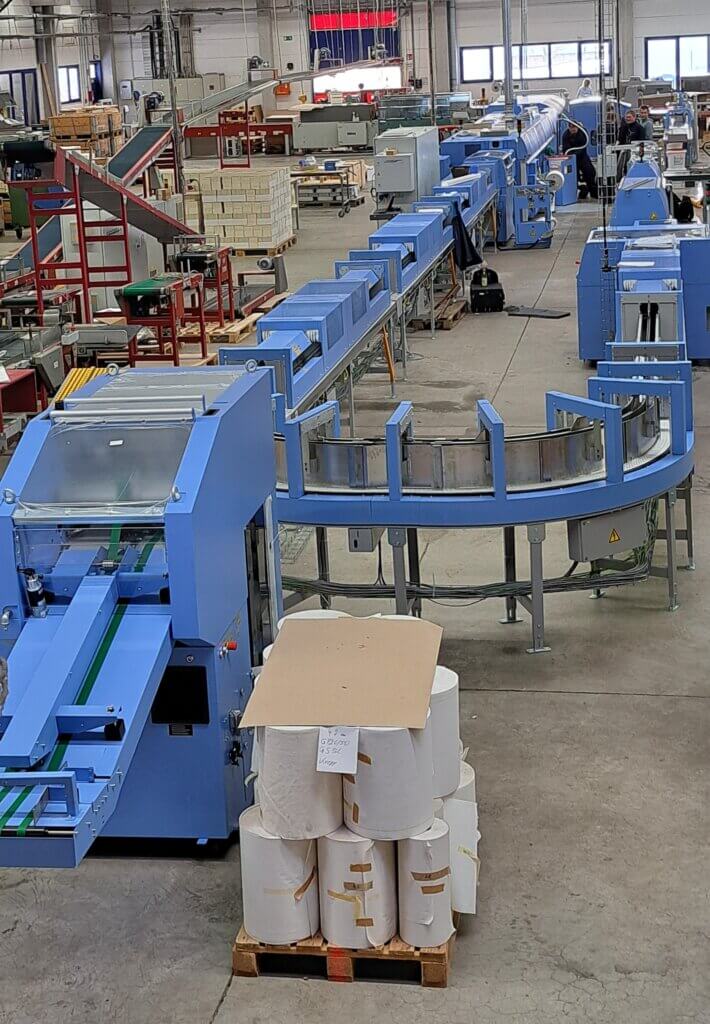Anyone deciding to print a book may be faced with the question: paperback vs hardcover – which format is the right one? Both types of book have their specific advantages and are suitable for different purposes. While the paperback is known for its flexibility and lower costs, the hardcover scores points for its durability and high-quality appearance. In this article, we shed light on the differences between paperback and hardcover and provide you with a decision-making aid. You can also find out about the technical options offered by Beltz Grafische Betriebe to professionally implement your book project.
What is the difference between paperback vs hardcover?
Material and processing
A paperback is a book form that falls between the high-quality hardcover and the compact paperback. The flexible cover is made of thick paper or thin cardboard and is usually
The development of the paperback format dates back to the 19th century, when the demand for inexpensive books suitable for the masses increased. Today, it is one of the most popular book formats on the market. It is produced using either offset or digital printing, whereby the book block is glued to the cover after printing. To make the paperback more durable, the cover is often provided with a protective film.
Hardcovers, on the other hand, are characterized by a sturdy book cover made of solid cardboard or paperboard. The book block is joined with an adhesive binding or thread stitching and glued to the cover via an endpaper. This more complex processing makes hardcovers more durable and of higher quality, but also more expensive to produce.
Typical areas of application
Paperbacks are widely used in the book trade and are particularly popular for novels, thrillers, non-fiction and guidebooks. They offer an attractive alternative to hardcovers, as they have a high-quality appearance but can also be produced cost-effectively. Paperbacks are a particularly interesting choice for self-published authors, as they offer a professional look without incurring high production costs.
Hardcovers, on the other hand, are often used for first editions, limited special editions or high-quality specialist books. Illustrated books, cookbooks and children’s books are also often published in hardcover, as they are more durable due to the sturdy binding. In bookshops, you will often find a hardcover edition first, before a cheaper paperback version follows if demand is high.
Depending on the target group and intended use, the choice between paperback vs hardcover can be a strategic decision. While paperbacks are more attractive in terms of price and more practical for on the go, hardcovers stand for value and durability.

Advantages and disadvantages in direct comparison
Advantages and disadvantages of paperback
The paperback has established itself as one of the most popular forms of book because it offers a good balance between quality and cost. It is significantly cheaper to produce than a hardcover and enables authors and
Another big advantage is portability. Paperbacks are lighter than hardbacks, take up less space and are therefore ideal for readers who want to take books with them on the go. The flexible material also makes for a pleasant reading experience, as the book is easier to hold and easier to turn the pages.
However, the paperback also has disadvantages. It is less durable than a hardcover, as the cover is flexible and the spine can develop reading creases more quickly. In particular, books that are often passed on or used intensively show signs of wear more quickly. Paperbacks are therefore used less frequently in libraries or schools, as hardbacks are more durable.
Ultimately, the decision paperback vs hardcover depends on the individual requirements of the book – for price-conscious readers and the mass market, it is an excellent choice.
Advantages and disadvantages of hardcovers
Hardcover books are considered the finest form of book binding. Thanks to the sturdy cardboard or paperboard binding, they are particularly durable and retain their shape even after frequent use. Especially for books that are intended as collector’s items or gifts, the hardcover offers a high-quality look and feel. In addition, various finishing techniques such as embossing, dust jackets or ribbon markers allow for an even more elegant design.
Another advantage is the stability. As the spine is not glued directly to the cover, but is connected via an endpaper, the binding remains more flexible and the book can be opened further without the pages breaking or coming loose. This is a decisive factor, especially for illustrated books, cookbooks or specialist books.
However, hardcovers are also more expensive to produce and take up more space on the shelf or in your bag. They are also heavier, which makes them less practical for traveling. Many publishers therefore initially opt for a hardcover first edition and later bring the book onto the market as a cheaper paperback.
The choice between paperback vs hardcover is ultimately a trade-off between price, durability and target group – each format has its own strengths and areas of application.
Important factors for the right choice
Target group and use
The choice between paperback vs hardcover depends heavily on the target audience and the intended use of the book. Paperbacks are ideal for a wide audience as they are inexpensive and well suited for everyday use. Frequent readers
Hardcovers, on the other hand, often appeal to a target group that values quality and longevity. Collectors, libraries and bookshops often prefer hardcover editions as they are more durable and remain of high quality even after frequent use. Books that are intended as gifts are also usually first published in hardcover, as the embossing or dust jackets make them look particularly classy.
If you want to make your book accessible to a wide readership, you can first publish a hardcover version and later offer a paperback as a cheaper alternative. This way, the question of paperback vs hardcover sometimes doesn’t even have to be asked.
Production costs and sales strategy
In addition to the target group, production also plays a major role in the decision between paperback vs. hardcover. Paperbacks are significantly cheaper to produce as they are made with an
Hardcovers, on the other hand, are more expensive to produce but have a higher sales value. Publishers often use hardcover editions for first editions in order to emphasize the exclusive character of a book and achieve a higher margin. Hardcovers are also more durable, which makes them particularly attractive for specialist or art books.
If you are planning for the long term, you can work with a staggered strategy: Publish a high-quality hardcover first and follow it up later with a cheaper paperback to appeal to a larger target group.
Look and feel
The external appearance of a book also plays an important role in the paperback vs. hardcover decision. Although paperbacks are flexible and practical, they cannot convey the same value as a hardcover. Nevertheless, there are many design options to give a paperback a high-quality appearance – for example with matt or glossy protective foils or a high-quality cover design.
Hardcover books offer more scope for creative finishes. Embossing, ribbon markers, dust jackets or special varnishes give them an elegant look and a special feel. This makes them particularly suitable for books that are intended as collector’s items or should have a long-term value.
Ultimately, the desired effect is decisive: if the book is to be classy and durable, the hardcover is the better choice. If it is a practical and cost-effective format for a broad readership, the paperback is ideal.
Technical possibilities at Beltz Grafische Betriebe
High-quality printing and binding techniques
When producing books, there are various printing and binding techniques that are used depending on the format and requirements. Paperback vs hardcover – both variants require precise workmanship and high-quality materials to create a durable and attractive end product.
Paperbacks are usually produced with perfect binding. The book block is fixed to the spine with a special adhesive. This technique enables cost-effective and efficient production, making paperbacks particularly suitable for large print runs. Modern adhesive bindings, such as PUR binding, also ensure improved durability.
Hardcover books, on the other hand, are often produced with thread stitching or reinforced adhesive binding. The book covers are made of sturdy cardboard or paperboard and are attached to the book block via an endpaper. As a result, hardcovers are particularly hard-wearing and retain their shape even with intensive use.
At Beltz Grafische Betriebe, various binding processes are available to produce both paperbacks and hardcovers of the highest quality. Customers can choose from various materials, formats and finishes to perfectly adapt their book to their needs.
Finishing options for both formats
Whether paperback vs hardcover – the choice of finish can have a significant impact on the appearance and value of a book. While paperbacks can be enhanced with a protective film or a special cover, hardcovers offer even more options for individual design.
Matt or glossy laminated covers are particularly popular for paperbacks, which not only enhance the book’s appearance but also protect it from wear and tear. A partial UV coating can also highlight certain elements of the cover and provide a special feel.
Hardcovers offer additional options to give the book a particularly high-quality appearance. Embossing, dust jackets, ribbon markers or relief printing give the book an exclusive touch. The spine can also be customized – for example with a round or straight spine or with special embossing that highlights the title.
At Beltz Grafische Betriebe, there are numerous options for designing a book exactly according to your own ideas. Depending on the intended use, customers can decide which finish is best suited to their project – whether a robust, elegant hardcover or a flexible, modern paperback.

Conclusion: When which format is worthwhile
Summary of the most important differences paperback vs hardcover
The choice between paperback vs hardcover depends on various factors – including target audience, intended use and production budget. Paperbacks are a cost-effective and flexible solution, ideal for the mass market, frequent readers and self-publishing. They are lightweight, handy and perfect for traveling. Hardbacks, on the other hand, offer a high-quality look, are more durable and are often used for collector’s items or first editions.
There are also clear differences in production. While paperbacks are usually produced with an adhesive binding, hardcovers use more stable materials and finishes. Depending on the book project, you should carefully consider which variant is more suitable.
Recommendation depending on the book project
When it comes to producing a book as cheaply and flexibly as possible, paperback is the right choice. Novels, specialist books and guidebooks in particular benefit from this format. Hardcovers, on the other hand, are ideal if a high-quality, long-lasting book is required – for example, illustrated books, art books or special editions.
At Beltz Grafische Betriebe, various printing and binding techniques are available for both book formats. This means that every book project can be realized individually and professionally – whether paperback or hardcover.
Let us advise you and take advantage of our technical possibilities
Whether paperback or hardcover – as you have now read, the choice of the right book format depends on many factors. Should your book be flexible, light and inexpensive or should it be high-quality, durable and elegant? Each type of binding has its own advantages and the decision should be well thought out.
At Beltz Grafische Betriebe, we offer state-of-the-art printing and binding techniques for both variants. From classic perfect binding for paperbacks to high-quality thread stitching for hardcovers – we will realize your book project exactly according to your ideas. In addition, numerous finishing options are available to optimize the desired format.
Let our experts advise you and find the perfect solution when deciding between paperback and hardcover. Contact us and discover the technical possibilities available to you at Beltz Grafische Betriebe.


